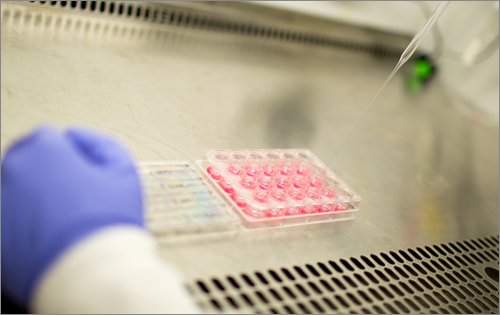The rapid development of DNA-modifying biotechnologies, such as genome engineering methods with their unprecedented potential to transform many aspects of medicine, biomanufacturing and the environment, has opened a new era of genetic design. DNA, the genetic code that determines cell and body composition of all organisms, now can not only be sequenced and synthesized with ever increasing speed and ease but also re-written in living cells and organisms. In laboratories, harmful DNA mutations may be reverted to normal or, vice versa can be introduced in otherwise normal genomes to study their functions in life models.

Among the available genome engineering tools, the CRISPR-Cas9 system has garnered most attention owing to its precise and tunable ability to target any location in a genome and its ease of use in living cells. Its many potential applications span areas as diverse as the repair of individual malfunctioning or disease-rendering genes, the activation of genes promoting organ-specific stem cell differentiation processes relevant to regenerative medicine and transplants, and so-called ‘gene drives’, which can ‘drive’ a desired gene through or dilute an unwanted gene out of entire populations of fast reproducing plant and animal species. Successful gene drives could be introduced into malaria-transmitting mosquitos to help control the spread of disease in humans, into crop-damaging insects and weeds to revert pesticide and herbicide resistance, and into invasive species to neutralize their menacing impacts on threatened ecological niches.
The extraordinary ability to realize advanced technologies like gene drives engineered with CRISPR-Cas9 in laboratory settings, however, has also created a different demand for evaluating and ascertaining biosafety, biosecurity and environmental safety that cannot currently be fulfilled with existing protocols of regulatory oversight.
To ensure biosafety and biosecurity within its laboratories, the Wyss Institute has proactively begun to develop a protocol designed as an enhanced operating standard for the institute’s research involving emerging biotechnologies. The protocol pairs the exploration of new technologies in laboratories with an extended set of risk-management measures and incorporates established biocontainment practices and procedures with additional layers of controls, including potential molecular or environmental controls. At the same time the Wyss Institute investigators are seizing the opportunity to develop, characterize and test additional safety features that are tailored to specific emerging technologies with potential security concerns. Organized in a multi-tiered framework, the newly devised biosafety and biosecurity procedures are:
- aligned with the activities of Harvard University’s review committees for safety and regulatory oversight,
- adaptable to new research scenarios and future technological innovations and
- made available with the important goal to foster fully transparent biosecurity-enhancing discussions between research laboratories and institutions, and with government partners.
The Wyss Institute’s principle considerations in developing these procedures are:
- The oversight process of the federal government was not created to capture the wide variety of rapidly advancing emerging biotechnologies with potential biosecurity concerns. In some instances, research with emerging biotechnologies may introduce potential dual-use concern, but is not performed with a “listed agent and toxin” that enacts the federal Dual Use Research of Concern (DURC) policy. Emerging technologies must be carefully reviewed for not only safety risk, but for often associated (bio)security implications.
- For research and technology that has existing regulatory oversight, the Wyss Institute is a leader in compliance and accountability. With the breakthroughs occurring in biotechnology, the research community and the institutions that house them have the opportunity to guide policy development and work to create plans for continuance of new technology in a safe and secure manner. Since emerging technology with potential biosecurity concerns, a dynamic oversight process is adopted at the Wyss Institute to ensure the research is carefully reviewed and properly controlled. The Wyss Institute actively anticipates government oversight of these emerging technologies in the future. As federal and international policy is developed, the Wyss will support implementation of new directives. Until then, conduct of research involving emerging technologies, will have a systematic review process occurring at this institution.
- The Wyss Institute intends to serve as a reservoir of open sharing and transparency in risk assessment and evaluation. We will openly share information to help guide the process, and to promote the ability for this research to be performed safely and securely.
- The oversight process effectively uses a platform that comprehensively enables a risk management plan focused on biosafety and biosecurity implementation steps to occur prior to university committee review. This plan is collaboratively drafted by the researchers, institute administration, safety personnel, and others as deemed necessary. Resources and expertise involved in the risk management include experts that can advise on both positive and negative research outcomes. In some instances, our federal agency partners may be involved in the review. This need is assessed on a case by case basis.
By initiating this process, the Wyss Institute intends to stimulate a public discussion between stakeholders from the scientific community and regulatory agencies that will help to further shape the use of biosafety protocols for emerging biotechnologies and fine-tune them to specific experimental situations.
Three documents constitute the core of the Wyss Institute’s risk management plan for experimentation with risk-associated emerging technologies.
- Wyss Institute Risk Management Plan for Emerging Biotechnology [download]: provides a comprehensive framework to identify potential biosafety and biosecurity issues in emerging biotechnology. The plan generates an oversight process that is initiated by the review of proposed projects, and covering the projects’ research stages with continuous reevaluation tools and mitigation procedures.
- Wyss Institute Operating Standards for Risk Management of RNA-Guided Gene Drives [download]: summarizes how different strategies ensuring project-specific oversight over gene drive research are linked and intertwined within a structure enabling multi-tiered coverage of biosafety and biosecurity.
- Wyss Institute Risk Management Plan Template Form [download]: collects risk management measures to be taken at the level of 1. Molecular Control and Ecological containment, 2. Biosafety level requirements and associated practices and procedures and 3. Experiment-specific Procedures for purposes of reporting, comparison and further development.
Reference
“Gene Drives” and CRISPR Could Revolutionize Ecosystem Management
Scientific American
By Kevin Esvelt, George Church and Jeantine Lunshof